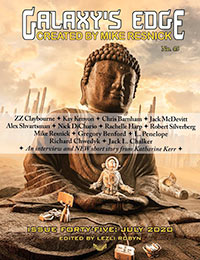Katharine Coldiron Reviews The Rending and the Nest by Kaethe Schwehn and Moon Brow by Shahriar Mandanipour
 The Rending and the Nest, Kaethe Schwehn (Bloomsbury 978-1-63286-972-2, $26.00, 304pp, hardback) February 2018.
The Rending and the Nest, Kaethe Schwehn (Bloomsbury 978-1-63286-972-2, $26.00, 304pp, hardback) February 2018.
A blurb of The Rending and the Nest could position it as a combination of Station Eleven and The Leftovers, but that would do the novel a major disservice. In structure, it resembles Station Eleven, because the struggle to endure after most of the world’s resources are no longer available is the main practical concern of the book. Emotionally, it resembles The Leftovers, because it is so bound up with grief over the loved ones lost in a mysterious reckoning. In reality, though, The Rending and the Nest is its own book: a wise and aching elegy for objects and our twenty-first century attachment to them.
An unexplained event (the Rending) cleanly removes the majority of the world’s population, but also the majority of its viable goods. It also erases portions of buildings and other large-scale fabrications, and alters the atmosphere so that there is no sunlight or rain, only a constant overcast grayness. Whether this event is a cosmic or religious phenomenon is unknown. Patterns regarding what has been removed and what lingers in the Rending do exist, but they are subtle, and seeking them out drives some of the novel’s characters to terrible deeds, or madness.
The characters are the heart of this quiet, splendid novel. The cast is pretty large, even unwieldy, but the central few characters create and navigate absorbing dramas. Narrator Mira is pleasingly and intriguingly flawed, as are her friends, Lana and Chester, her lover, Rodney, and an enigmatic antagonist, Michael. Vanished characters like Mira’s brother, Bim, come alive as well in Schwehn’s able prose. What also comes alive, in a way that readers born after about 1975 are likely to cherish, are the cultural elements of life in the early 21st century. Television shows, brand names, the rituals of teenage life in America are all woven into the memories and language of the characters. This specificity is a relief in a landscape of literary writing so minimalist, attempting such universality, that the characters meet for coffee at unnamed shops instead of Starbucks and drink water out of glasses instead of crackling Arrowhead bottles. “The dum-dum of the Law and Order scene break chimed in my head.” Yes, that sound. It’s in all our heads.
I have not scratched at the primary plot thread of the book, which is the strange births. For the first few years after the Rending, no pregnancies occur in Zion, the small community Mira and her friends have built. When women do begin to give birth, their children are objects, inanimate consumer goods that have been grown and labored exactly like human infants, but with none of their biological properties. These Babies (Schwehn’s incessant capitalization of objects with special resonance after the Rending gets a little tiresome) make unanswered questions about the Rending even more puzzling and stir questions about the emotional aspect of parenthood.
Of course I’d heard about a mother’s love, but I’d expected some gentle stirring… The feeling was not gentle. It did not come on softly. It was violent and abrupt: the sudden roar of an airplane right above your head. One minute you see the airplane and the next minute you belong only to that sound. I belonged only to the sound of wanting my Baby. I was feral.
Like other plot elements in The Rending and the Nest, this line of action seems bizarre and difficult to build a book around, but in practice, it’s profoundly compelling. The unlikeliness of the book’s journeys resembles the novels of Ann Patchett: the sense that what’s happening is not at all realistic, but you’re eagerly following along. Some part of you knows that it’s a novel, and higher-level realism is simply not necessary. Michael’s ability to gather up followers into a kind of cult based in the Minnesota Zoo seems farfetched if you side-eye it, but if you go with it, marvelous narrative possibilities unfold.
Schwehn’s novel is at its most effective when considering the textures of everyday life: “My father’s bare feet on the warm shingles. My mother’s thumb on the edge of those vases. Behind all these gestures might be stories I didn’t want to hear.” But it’s at its most bewitching when considering objects, particularly consumer objects, and the significance or lack thereof within them. The book is bound up in objects and their resonance so richly that as the book’s plot and characters unfold, the complexity of objects multiplies, and then multiplies again. The effect is dazzling.
There’s much more to say about The Rending and the Nest: the lack of art left behind after the Rending, what the survivors have in common, the role of creation in the new world, the strong resemblance of the whole affair to a series of dreams. What kind of book is so specific, so based in the detail of the moment, and yet so luminously rendered that it feels like stepping into someone else’s dream? This kind. It’s a book to savor, to consider deeply, to weep over, to read again, to pass on.
SHORT TAKE
Moon Brow, Shahriar Mandanipour (Restless Books 978-1632061287, $21.99, tp, 464pp) April 2018.
In premise, a stunner: a young man returns from the Iran-Iraq war of the 1980s with the scribe of virtue on his right shoulder and the scribe of sin on his left shoulder. These scribes narrate the man’s story as he tries to recover his memories, particularly those connected to the women he left behind. In practice, this book is impossible: obsessed with sex in a juvenile, chauvinistic way; unevenly secretive, and repetitively static; translated dutifully in words, but translated barely at all in cultural or historical ways. Moon Brow draws from a rich context of Persian folktales and the troubled history of the region in the late 20th century, but most of that is lost on the Western reader – this is hardly Persepolis, with its exceptional clarity and culturally open arms. Mandanipour is one of the most celebrated authors in contemporary Iranian literature, so it’s possible that this is the wrong book for an American audience, but it’s also possible that it’s simply a dud. There are mysterious dream sequences and fine set pieces in war zones, but there’s also family bickering depicted at great length. Unsympathetic characters, a slow start, and narrative strategies that are intriguing but ultimately muddled and difficult to follow make this lengthy novel an easy one to pass over.
Katharine Coldiron is the author of Ceremonials (Kernpunkt Press), an SPD fiction bestseller. Her work as a book critic has appeared in The Washington Post, The Believer, The Guardian, and many other places. She lives in California and at kcoldiron.com.
This review and more like it in the September 2018 issue of Locus.
 While you are here, please take a moment to support Locus with a one-time or recurring donation. We rely on reader donations to keep the magazine and site going, and would like to keep the site paywall free, but WE NEED YOUR FINANCIAL SUPPORT to continue quality coverage of the science fiction and fantasy field.
While you are here, please take a moment to support Locus with a one-time or recurring donation. We rely on reader donations to keep the magazine and site going, and would like to keep the site paywall free, but WE NEED YOUR FINANCIAL SUPPORT to continue quality coverage of the science fiction and fantasy field.







